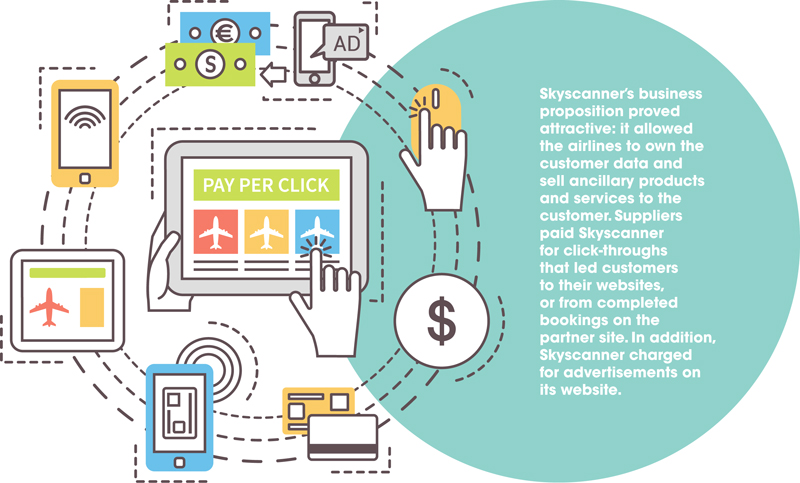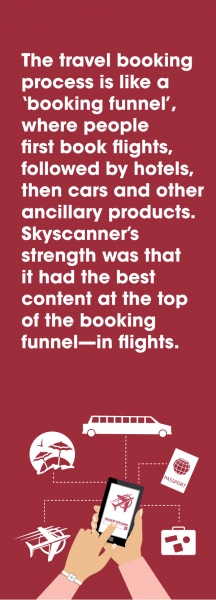In order to compete in Asia Pacific’s one-stop travel market, Skyscanner reinvented itself from the inside out.
The number of websites and apps offering comparative pricing for travel consumers has grown hand in hand with advances in technology, enabling a rapid response to enquiries that were once calculated manually by teams of travel agents. Skyscanner, for example, provides an easy way to compare prices across different airlines when booking a flight. It combines proprietary search technology with content sourced from a comprehensive supplier base of airlines and online travel agents (OTAs) to create a technology platform that allows users to find and compare travel options quickly and accurately.
Now a global enterprise with a foothold in the Asian market, Skyscanner was founded in 2003 by three friends in Edinburgh, the United Kingdom. Initially, the company relied primarily on word-of-mouth marketing. The founders pursued a conservative expansion strategy that accepted slower growth in the early years, but also enabled them to maintain control and ownership while building a solid foundation for the firm’s unique product offering. Once Skyscanner had established itself in the European market, it looked to expand into Asia.
In June 2011, Skyscanner opened an office in Singapore, which was to serve as a sales and marketing hub for the region. It gradually became a full-fledged service office with engineering and technology development capabilities. However, the move was not without its challenges.
Bringing the business model to Asia
Although the business potential was readily acknowledged, Asia was often perceived by western companies to be just as homogenous a region as continental Europe, with most not readily comprehending the diversity of Asia. This posed an opportunity and a challenge for Skyscanner. It needed to adapt its offering to individual Asian markets, as well as make its Asian business nimbler and more responsive to the needs of local customers.
CUSTOMER BUYING PATTERNS
Important differences in the behaviour and preferences of customers throughout Asia, as compared to Europe, included a preference for accessing the Internet from mobile phones instead of computers. In 2013, globally, more than 50 percent of the company’s traffic was accessed from a mobile device, like smartphones and tablets. As Andy Sleigh, Skyscanner’s General Manager for Asia at that time, discovered, this figure was higher in certain Asian markets. “It’s probably 60 percent or more. A lot of our new customers in Asia will never access the Skyscanner site on their desktop computers.”
Differences in online browsing and payment habits were also present. In the western model, people generally started their search using a search engine, such as Google, or would go directly to a website that they trusted. But in Asia, not everyone starts off a search on a search engine, says Sleigh. In China, for instance, people spend almost all of their Internet time on WeChat. Buying habits too are unique. Most people in Asia prefer to book directly with the supplier—be it an airline or a hotel—because they believe that customer service will be more reliable.
Another point of difference relates to the popularity of package holidays. “If you go to any online travel site in Asia, they always lead with packages,” noted Sleigh, “Whereas in most of Europe, while package holidays are popular, they are not something that we’ve ever focused on and made much revenue from.”
PARTNERS FOR DOMESTIC TRAVEL
Improvement in the company’s domestic travel offering in Asia was another challenge. Skyscanner’s platform did not always have comprehensive information on local travel agents, who sometimes offered better prices than the local or international airlines. It also took Skyscanner longer to convince the Asian airlines to partner with it for local flights because they were used to working with their network of trusted online travel agents.
Sleigh cites the example of South Korea, where 98 percent of the searches on Skyscanner related to international travel, or for travel between two destinations outside the country. Nevertheless, the domestic market in South Korea was significant—for instance, Jeju Island to Seoul was the busiest air route in the world, with ten million people travelling the route annually.
Two sides of the same coin
Skyscanner entered Asia with the same business approach it had adopted in Europe in 2003, a direct-connect model where the company worked with airlines to connect them to potential customers. Strengthening both sides of the platform in a new market as complex as Asia posed a chicken-and-egg problem that the company had to learn to tackle.
“This is a two-sided platform”, explains Sleigh, “You cannot go to a commercial partner, such as an airline, and say, ‘Hey, can you pay us for these referrals in terms of traffic?’, unless you have significant traffic coming to them from your website. And you can only get significant traffic, if you have great content for your users, and that comes from the commercial partners.”
Initially, the commercial partners that Skyscanner approached were the direct suppliers (airlines) or OTAs that uploaded their flight information onto the Skyscanner platform. The airlines and the OTAs benefitted from being on the Skyscanner platform because it enabled them to receive ‘qualified’ traffic at a low cost. As Sleigh explains, “When I say ‘qualified’, it means that someone who comes to the suppliers from a Google search is much less likely to complete a transaction than someone who comes from our website. People who start on the Skyscanner site generally have a real intention to buy.”
Skyscanner’s business proposition proved attractive: it allowed the airlines to own the customer data and sell ancillary products and services to the customer. Suppliers paid Skyscanner for click-throughs that led customers to their websites (cost-per-click deal), or from completed bookings on the partner site (cost-per-acquisition deal). In addition, Skyscanner charged for advertisements on its website.
The more comprehensive Skyscanner’s website was in terms of partners on the platform, the more attractive it proved to be for customers who wanted a one-stop portal for travel-related information. Skyscanner’s powerful technology platform enabled the company to return search results on its site faster than most competitors—sifting through about four billion data points in seconds.

Organisational structure in Asia
Overall, the Asia business took its cue from the Edinburgh head office. For example, marketing campaigns originated from the head office and were pushed to Asia through the Singapore office, with minor adaptations for each country. However this centralised approach was often inadequate when it came to trends in Asia.
Singapore was seen as the regional hub for Asia, the same way Edinburgh had been developed into a hub to serve Europe, and Miami for the Americas. All Asia Pacific employees were based in Singapore, unless they were needed elsewhere for local relationship building and local knowledge gathering.
In Australia, where the business culture was relatively casual, it was possible for a Skyscanner salesperson to pick up the phone, explain the product and make a sale, all without even meeting the person on the other end of the phone. So the company was able to do well in Australia without a local team on the ground. In contrast, the industry culture was more formal in Japan and China, and Skyscanner had to adapt accordingly. Commercial discussions with suppliers in these countries had to take place face-to-face.
Capturing the Asian skies
By 2014, Skyscanner had achieved global reach. As of October 2014, it had become the number one travel search site, with 71 million visits and 35 million visitors a year from 45 countries, with 56 percent of them being repeat users—huge numbers in the Internet industry. Within 12 months, the company moved to hotels, car hire and data products under the brand ‘Skyscanner for Business’. It also acquired four companies and expanded from four offices to nine in just one year.
By February 2015, Skyscanner was achieving solid performance in Asia Pacific; the region was contributing almost 20 percent of the company’s global revenue and bringing more than 20 percent of visitor numbers. Its 2016 target was to become the biggest region in terms of revenue and traffic.
Marketing at scale
Although Skyscanner had rolled out local websites for 14 countries in Asia Pacific by May 2015—a testimony to the powerful tool for savvy travellers it had developed—Sleigh felt that the company still had some way to go in terms of brand positioning, particularly in Asia. “The challenge for us was that a lot of people are booking online travel for the first time…How do they discover us and why should they use us? And why should they keep using us?”
He saw the travel booking process as a ‘booking funnel’, where people tend to book flights first, followed by hotels and then cars and other ancillary products. Skyscanner’s strength was that it had the best content at the top of the booking funnel—in flights.
While airlines enjoyed the highest volume of sales through Skyscanner, flights offered the lowest margin among all travel products. Most OTAs sold flights at cost or at a loss, and then added on a hotel or car hire, where they made money. Nevertheless, flights still contributed to the majority of Skyscanner’s revenue—well over 50 percent—although this proportion was gradually decreasing. Hotel services was the next biggest item, followed by car rental. While the data products business was still relatively small, it was probably the fastest growing of all of Skyscanner’s business divisions.
Being able to ‘market at scale’ involved two of the company’s biggest challenges to date. Firstly, the portal needed to shift from being a source of information primarily for flights to that of all travel products. Secondly, the frequency with which people returned to the Skyscanner website needed to be increased. This meant that Skyscanner had to work towards providing more relevant and contextualised content for users of the site.

‘Squadification’
The rapid growth in the company also precipitated many internal challenges. In 2014 alone, staffing levels grew from 200 to 500 people globally, expanding to a point where it started to create bottlenecks. “Different teams were becoming clogged with just too much stuff to do, with repercussions on other parts of the business,” recalled Sleigh. The solution was ‘squadification’ in which interdisciplinary teams were tasked with a long-term goal of designing, developing, testing and releasing new functionality into production. Squadification was rolled out at the end of 2014 to selected areas of the business.
In a rapidly scaling Internet business, Sleigh notes, one needed to allow people to own specific bits of the website or app, so that they can just get on and optimise it. “The beauty of the Internet is that you can continually optimise, and you could be running thousands and thousands of tests concurrently in a very short period of time to see what works and what doesn’t. For example, we have a team of eight people that just focuses on decreasing bounce rate from our website. And that is all about increasing the first impression a new visitor has when they land on our site.”
Squadification also led to a decentralisation of technology development from the global head office in Edinburgh to the regional head office in Singapore. In addition, decentralisation required product innovation to be driven partially from Asia, and eventually at the country level.
Sleigh believed that the combination of squadification and decentralisation would help Skyscanner become nimbler and more competitive, and his efforts paid off. In May 2015, the global search site became Scotland’s first US$1 billion Internet economy business. By the end of that year, with 60 million monthly active users, Skyscanner went on to record revenues of US$146 million, up 29 percent from the previous year. A year later, in November 2016, just 13 years after its founding, Skyscanner was acquired by Ctrip.com International Ltd, China’s biggest online travel company, for US$1.7 billion.